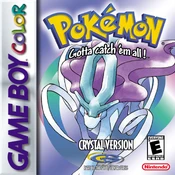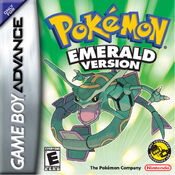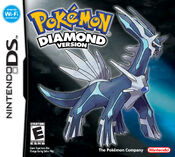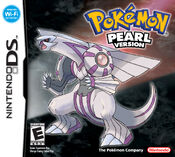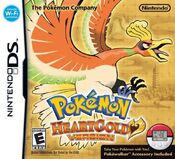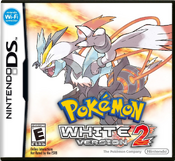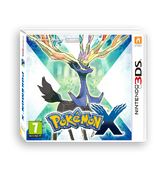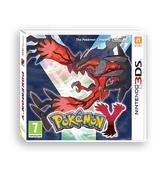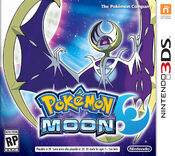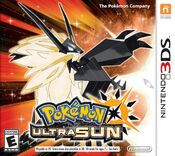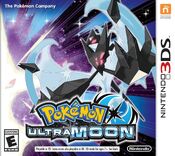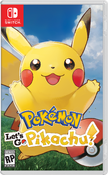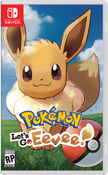
|
This article or section requires a cleanup in order to meet the Pokémon Wiki's quality standards. Reason: Some of the info belongs in the core series article Please consider editing this page to improve it. |

|
- For other uses, see Pokémon.
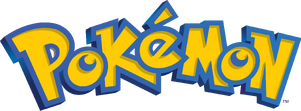
The official logo for the Pokémon franchise since 1998
Pokémon (Japanese: ポケモン, Hepburn: Pokemon), short for Pocket Monsters (Japanese: ポケットモンスター, Hepburn: Poketto Monsutaa), is a long-running multi-billiondollar media franchise created by Satoshi Tajiri at Nintendo. It centers around a group of fantasy creatures known as Pokémon, from which the series takes its name. A group of humans known as Pokémon Trainers catch Pokémon and train them to battle other Pokémon for sport and/or as loyal companions, with their main goal is to become the Pokémon Champion while preventing a wicked group of Trainers known as villainous teams from causing danger to the world. Although Pokémon is technically a role-playing video game series, similar to Final Fantasy, Dragon Quest and others, an animation series, manga, and a trading card game also make up large aspects of the franchise. Pokémon is managed by The Pokémon Company, a company formed by Nintendo, Game Freak, and Creatures Inc.. It is one of Nintendo's flagship franchises, alongside Mario and The Legend of Zelda. The mascot of the Pokémon franchise is the yellow Generation I Electric-type mouse Pokémon named Pikachu.
The main series in the franchise is the eponymous Pokémon series, consisting of RPG games that typically involve a player character (whose name is decided by the player) starting their journey as a Pokémon Trainer after receiving their First partner Pokémon from the Pokémon Professor at the local Pokémon Lab. The professor also gives them a Pokédex, and tasks them to fill it with data entries on Pokémon to aid their research; this is accomplished by obtaining every Pokémon species within that game. The franchise as a whole debuted with Pocket Monsters Red and Pocket Monsters Green on February 27, 1996 in Japan and Pokémon Red Version and Pokémon Blue Version in September 1998 in North America, on the original Game Boy, and every game since had been released in pairs (sometimes having a third special edition version shortly after, such as Pokémon Yellow Special Pikachu Edition or Pokémon Crystal Version). Although the two paired games are identical, the main difference between them is the type of Pokémon encountered, and therefore, it is impossible to collect every Pokémon and complete the Pokédex in one game without trading Pokémon with other players between individual versions, itself a contributing factor of its popularity. Every main Pokémon series installment has been released for a handheld device until Pokémon Sword and Pokémon Shield for the Nintendo Switch, a hybrid home console with a portable handheld mode.
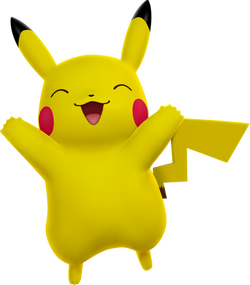
Pikachu, the mascot of Pokémon
The Pokémon franchise consists of several spin-off titles. Three of such series, Pokémon Stadium, Pokémon Mystery Dungeon and Pokémon Ranger, are also role-playing games, as well as two main series-related titles for the Nintendo GameCube: Pokémon Colosseum and Pokémon XD: Gale of Darkness. There is also a beat 'em up series, Pokémon Rumble, several puzzle games, such as Pokémon Puzzle Challenge and Pokémon Trozei!, and an adventure game titled Detective Pikachu, which was shortly followed by a live action film of the same name. A digital pet game is occasionally released for the Pokémon franchise, such as the Pokémon Pikachu handheld, Hey You, Pikachu!, Pokémon Channel, and My Pokémon Ranch, a majority of which are centered around Pikachu specifically. In 2016, an augmented reality mobile game titled Pokémon Go was released for iOS and Android, and has effectively become the best-selling game of the entire franchise. Due to its adventurous gameplay and overall theme of bondage to the Pokémon, Pokémon has since become the highest-grossing media franchise of all time. It is the fourth best-selling video game franchise, behind Nintendo's own Super Mario franchise, Tetris and Call of Duty, with more than 480 million copies sold as of 2024.[1] In terms of Nintendo's series, it is second-best selling video game franchise as well, behind Mario but after The Legend of Zelda. Pokémon Go itself surpassed over a billion downloads.[2] The anime series is regarded as the most successful video game adaptation of all time.[3]
Early history[]
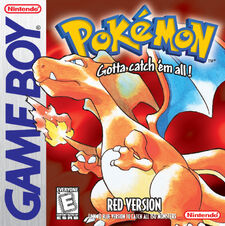
, one of the two very first games of the series released internationally alongside
The concept of Pokémon stems from the hobby of insect collecting, a popular pastime of series creator Satoshi Tajiri during his childhood.[4] He first conceived the idea of Pokémon as early as 1990 as Capsule Monsters. The following year, Tajiri discovered the Game Boy's Game Link Cable and imagined an insect crawling across the Game Link Cable between two Game Boy units. Tajiri therefore felt it was the ideal system for his game.[5] Tajiri cited The Final Fantasy Legend as an inspiration for Pokémon, as the game's success proved that the Game Boy could handle more than just action games.[6] Concepts of capturing Pokémon, and designs and etymology of Pokémon were also largely influenced by classic tokusatsu franchises most notably Godzilla, Gamera, Ultraman, and Kamen Rider.[7][8][9][10]
When Satoshi Tajiri first pitched the idea of Pokémon to Nintendo, they could not quite grasp the concept, but were impressed enough with Tajiri's game design reputation that they decided to explore it. Legendary game designer Shigeru Miyamoto (the creator of Mario, Zelda, and various other Nintendo series) began to mentor Tajiri, guiding him during the creation process.
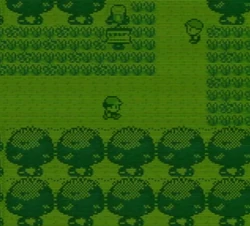
The Generation I Pokémon games as it appears on the Game Boy, clearly depicting outdated hardware graphics in comparison to later games
Pocket Monsters Red and Green, unlike all subsequent games, took several years to produce, and nearly bankrupted Game Freak in the process.[5] Investment from Creatures Inc. allowed Game Freak to complete the games, and in return, Creatures received one-third of the rights to the Pokémon franchise.[11] By the time the original games were released in Japan in 1996, several TV shows and magazines were uninterested, as they thought the Game Boy, which was released in 1989 and have a dark green, low-contrast monochrome screen, was becoming obsolete. Unbeknownst to Nintendo at the time, Tajiri secretly programmed a 151st Pokémon named Mew into the games. Rumors of the elusive Pokémon drove further sales, and the games eventually became a hit. In 1997, following the success of Pocket Monsters Red and Green, an anime was produced, and it also became a success in Japan.[5]
However, in December 1997, the infamous 38th episode of the Pokémon anime, "Dennō Senshi Porygon", featured a scene in which Pikachu uses its signature Thunderbolt attack to destroy missiles. This was followed by bright red and blue strobe lights flashing rapidly for a couple of seconds (similar to effects seen in older video games); this resulted in several children watching the show to gain seizures, followed by 685 of them being hospitalized.[12] This incident became known as the "Pokémon Shock," and it resulted in the show being put on hiatus for several months.[5]
Around the same time as the Pokémon Shock incident, Game Freak was trying to negotiate with Nintendo of America to introduce Pokémon to the United States. Because news of the Pokémon Shock was the first time that Americans had heard of Pokémon at the time, it felt like a bad omen to Game Freak. Nintendo of America was concerned of the series' role-playing genre, as such games did not quite have the same popularity in America as in Japan. Nevertheless, Nintendo of America was excited at their aim to replicate the success of Pokémon in the United States and localize it for western audiences.[13] Following the release of Pokémon Red and Blue in 1998 and plentiful merchandise, Pokémon became an instant success in America and other countries, turning it into a worldwide sensation on-par with the Mario and The Legend of Zelda franchises.
Gameplay[]
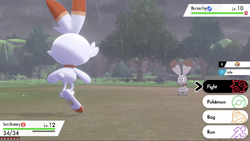
Gameplay screenshot of Pokémon Sword and Pokémon Shield, of a battle between the player's Scorbunny and a wild Bunnelby
The main Pokémon games all center around the strategic manipulation of creatures called Pokémon, from which the series takes its name. In the games, the player takes the role of a male or female human who has just received a license to catch Pokémon. The player usually goes to the local Pokémon Lab to receive a First partner Pokémon. In every main series game, the player is given a choice of three Pokémon; a Grass-type, a Fire-type or a Water-type (with very few exceptions). A person who possesses and trains a Pokémon of its own is called a Pokémon Trainer.
Using their first Pokémon, players are now usually free to set off on their own adventure, in which they will collect Badges by defeating the eight Gym Leaders. Once the player has collected eight badges, they can battle the Elite Four; four representatives of the Pokémon League that are considered the best Trainers in their respective region, and if successful, then must defeat the Champion, whose special Trainer is one step above the Elite Four.
Another goal of the game is to try to catch every Pokémon available; in the first Generation, there were only 151 Pokémon available, but with every new Generation the number of Pokémon increases. Currently, there are 1,025 known Pokémon, and nine regions/generations, with the very likely possibility of more being introduced in every new Generation.
Pokémon can be caught by weakening them with other Pokémon, and then capturing them in a Poké Ball, where they can be stored for future use, to battle and help capture more Pokémon. Each Pokémon has a health gauge, and whomever gauge runs out first loses; however, a trainer can have several Pokémon, so if one Pokémon's gauge reaches zero (called "fainting"), they must send out another Pokémon if possible. Each trainer can carry a maximum of 6 Pokémon although many more can be caught and stored in a PC. In order to try to knock out the opposing Pokémon, the player must order their Pokémon to attack the opposing team's Pokémon. Pokémon can learn up to four attacks, although there are many more techniques that they are capable of learning, so the player can replace one of its moves when they are ready to learn a move. During a battle, when all of an opponent Trainer's Pokémon have fainted, the player wins and earns money. On the other hand, if their own Pokémon have fainted and loses, they must depart to a Pokémon Center and give up a certain amount of money. They can also lose money if their Pokémon faint from a status condition (eg. Poison) or a wild battle. This occurrence is known as Blacked (or Whited) Out. In any case, it serves as the games' Game Over sequence.
Game releases[]
The games are generally released in pairs. For example, two games will be immediately released that are basically the same, except with several minor changes, and later, another improvement upon the last two games will be released. After this, work will begin on a new pair, which will have a vastly different story and various gameplay improvements. Examples of this are Pokémon Red Version and Pokémon Blue Version, which are identical, except certain Pokémon can only be obtained in either one. Shortly after the release of Pokémon Red and Blue, an improvement on these games was released; Pokémon Yellow Special Pikachu Edition, which featured color (international version only), and the addition of a Pikachu which followed the main character.
List of games[]
The following lists all of the games in the Pokémon franchise:
Main series[]
Game Boy[]
- Pokémon Red and Green Version (Japan)
- Pokémon Blue Version (Japan)
- Pokémon Red Version and Pokémon Blue Version (International)
- Pokémon Yellow Special Pikachu Edition (also known as Pokémon Pikachu in Japan, and released in this console only in that region)
Game Boy Color[]
- Pokémon Yellow Special Pikachu Edition (International version only)
- Pokémon Gold Version and Pokémon Silver Version
- Pokémon Crystal Version
Game Boy Advance[]
- Pokémon Ruby Version and Pokémon Sapphire Version
- Pokémon FireRed Version and Pokémon LeafGreen Version
- Pokémon Emerald Version
Nintendo DS[]
- Pokémon Diamond Version and Pokémon Pearl Version
- Pokémon Platinum Version
- Pokémon HeartGold and SoulSilver Version
- Pokémon Black Version and Pokémon White Version
- Pokémon Black Version 2 and Pokémon White Version 2
Nintendo 3DS[]
- Pokémon X and Pokémon Y
- Pokémon Omega Ruby and Pokémon Alpha Sapphire
- Pokémon Sun and Pokémon Moon
- Pokémon Ultra Sun and Pokémon Ultra Moon
Nintendo Switch[]
- Pokémon: Let's Go, Pikachu! and Pokémon: Let's Go, Eevee!
- Pokémon Sword and Pokémon Shield
- Pokémon Brilliant Diamond and Pokémon Shining Pearl
- Pokémon Legends: Arceus
- Pokémon Scarlet and Pokémon Violet
Upcoming[]
Spin-off[]
Game Boy[]
Game Boy Color[]
Game Boy Advance[]
Nintendo DS[]
- Pokémon Dash
- Pokémon Mystery Dungeon: Blue Rescue Team
- Pokémon Mystery Dungeon: Explorers of Time and Explorers of Darkness
- Pokémon Mystery Dungeon: Explorers of Sky
- Pokémon Trozei!
- Pokémon Ranger
- Pokémon Ranger: Shadows of Almia
- Pokémon Ranger: Guardian Signs
- Learn with Pokémon: Typing Adventure
- Pokémon Conquest
Nintendo 3DS[]
- Pokédex 3D
- Pokémon Rumble Blast
- Pokémon Dream Radar
- Pokémon Mystery Dungeon: Gates to Infinity
- Detective Pikachu
- Pokémon Shuffle
- Pokémon Rumble World
- Pokémon Battle Trozei
- Pokémon Picross
- Pokémon Super Mystery Dungeon
Nintendo 64[]
GameCube[]
Wii[]
- Pokémon Battle Revolution
- My Pokémon Ranch
- PokéPark Wii: Pikachu's Adventure
- Pokémon Mystery Dungeon (WiiWare)
- Pokémon Rumble
- PokéPark 2: Wonders Beyond
Wii U[]
Nintendo Switch[]
- Pokkén Tournament DX
- Pokémon Quest
- Pokémon Mystery Dungeon: Rescue Team DX
- Pokémon UNITE
- Detective Pikachu Returns
Mobile[]
- Pokémon Say Tap? (Japan)
- Pokémon TCG Online
- Camp Pokémon
- Dance? Pokémon Band! (Japan)
- Pokémon Shuffle Mobile
- Pokémon Duel
- Pokémon GO
- Pokémon: Magikarp Jump
- Pokémon Playhouse (North America and Europe)
- Pokémon Rumble Rush
- Pokémon Masters EX
- Pokémon Quest
- Pokémon Smile
- Pokémon Café ReMix
- Pokémon UNITE
- Pokémon Trading Card Game Pocket
Upcoming[]
Gallery[]
Core series[]
Logo timeline[]
Japanese[]
1997–2002 (Generations I and II)[]
English[]
1998–present[]
Trivia[]
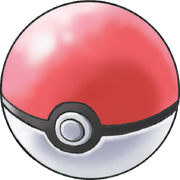
The Poké Ball, the item used to capture and store Pokémon, is the franchise's trademark symbol
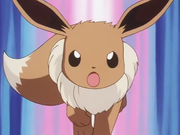
The Pokémon Eevee is widely known to be arguably the most beloved among fans
- The main symbol of Pokémon as a whole is the Poké Ball.
- The secondary symbol of the franchise is the mascot, Pikachu (mainly the anime series).
- Counting Mew, there are 151 original Pokémon.
- Surprisingly, Pikachu was not originally planned to be the mascot of Pokémon; It was going to be Clefairy, until the staff found the Electric-type creature more appealing.
- The infamous Psychic-type Legendary Pokémon Mewtwo comes before Mew in the National and Kanto Pokédex.
- Eevee, a Normal-type fox-like Generation I Pokémon, is a fan-favorite among the franchise with a cult-following rivaling if not surpassing that of Pikachu, and many believed this particular First partner Pokémon should be the mascot rather than the Electric-type mouse, especially since the release of the Pokémon FireRed Version and Pokémon LeafGreen Version and itself having many unique evolutions unlike any other Pokémon. Eevee, however, does currently serve as the series' secondary mascot.
- According to Tsunekazu Ishihara, the Pokémon Company's CEO, he revealed that Game Freak originally did not intend to bring Pokémon to the United States, because they thought American kids would not like RPG games "with a lot of texts" (unlike Japan). However, this gamble ended up profiting them, paying off around a staggering $100 billion.
- In addition to insects, Satoshi Tajiri launched the series inspired by kaiju, especially the equivalents from Godzilla and Ultraman.
- Satoshi Tajiri originally wanted to call the franchise "Capsule Monsters", but had to settle for its current name due to copyright.
- Junichi Masuda said it usually takes at least six months to design a Pokémon from the concept art stage to finalizing a design. But the more important Pokémon like Legendary Pokémon and First partner Pokémon typically have a design process for over a year.
See also[]
External links[]
- The Official Pokémon Website at www.pokemon.com
- Japanese website at www.pokemon.co.jp
- Pokémon at Wikipedia
- Pokémon at Bulbapedia
References[]
- ^ "Pokémon in Figures". The Pokémon Company (www.pokemon.co.jp).
- ^ "Pokémon Go spurred an amazing era that continues with Sword and Shield". The Verge. Published February 28, 2019.
- ^ "Why the Pokémon Anime is the Most Successful Adaptation of a Videogame Ever". USgamer. Published November 17, 2016.
- ^ "The Ultimate Game Freak". TIME (Wayback Machine). Published November 22, 1999.
- ^ a b c d "Beware of the Pokemania", page 3. TIME (Wayback Machine). Published November 14, 1999.
- ^ "Pokémon interview" (in Japanese). Nintendo of Japan (Wayback Machine).
- ^ 「ポケモン」を生んだ? 『ウルトラセブン』カプセル怪獣のたまらない可愛さ
- ^ Character Study about : Squirtle, Wartortle and Blastoise [Sunday Study]
- ^ ウルトラ怪獣手帳 に関する出典はこの本です。
- ^ 『エヴァ』『ポケモン』の元ネタは『ウルトラセブン』? アスカのプラグスーツが白かった理由
- ^ "Monster mash". Forbes. Published July 26, 1999.
- ^ "The Pokémon Panic of 1997". Skeptical Enquirer Volume 25, No. 3, pages 26–31.
- ^ "Beware of the Pokemania", page 4. TIME (Wayback Machine). Published November 14, 1999.









